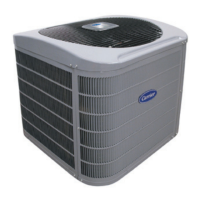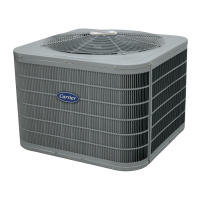25
• Clamp and run pipes neatly and straight using non laminated good copper tubing.
Recommended copper tubes sizes are mentioned in table for both models.
• The pipes should run as straight as possible, avoiding unnecessary turns and bends.
• The piping length between indoor & outdoor unit should not exceed 25meters including in
vertical lengthen after every 3meters there must be U-trap and number of bends should be
adhered to the minimum possible extent.
• In case if the piping length exceeds contact CARRIER SERVICE HELPLINE (Refer last
page of this guide), for other length, pipe sizes and extra refrigerant charge for extra pipe
length.
• If brazing is done to connect two tube lengths, it should be carried out using proper flux and
brazing rod (7.25% Phosphorus, rest copper) with a constant purge of nitrogen through the
piping to maintain a clear system.
• All connections must be leak tight.
7.5 NITROGEN GAS PURGING OR BLOW METHOD (DURING BRAZING)
If nitrogen gas is not passed through pipes during brazing, a film of oxidized material will form
on inner surfaces of pipes. Presence of such a film in system will adversely affect operation of
valves and compressor in refrigerant system and will prevent system from operating normally.
To prevent this, nitrogen gas is passed through pipes while brazing process is in progress.
This process of replacing air in pipes with nitrogen is also called ‘nitrogen gas blow’.
This is basic method that is used for brazing work as well as for pressure testing.
Procedure
1. Pressurize from the liquid pipes and gas pipes to 478 PSI (3.3 MPa) (and not above 478
PSI (3.3 MPa)).
2. If there is not pressure drop over the next 24 hours, the equipment has passed the test.
3. If the pressure drops, check for leakage positions. (Confirm that there is no leakage, then
release nitrogen.)
CAUTION
1. Use only nitrogen gas (recommended).
2. Use vacuum pump to evacuate/Vacuuming/
discharge nitrogen gas.
3. Vacuum pump must be with backflow
preventive function so that oil in the pump does
not set backflow into pipe of the air
conditioning system, when pump stop.
4. For the vacuum pump, check that oil is filled up
to the specified line of the oil gauge.
5. A two - stage regulator should always be used
while carrying out this method.
6. Always be sure to use a pressure – reducing
valve.
1. Do not use Oxygen, Carbon dioxide,
Fluorocarbons etc.
2. Do not discharge refrigerant gas in
surrounding to preserve terrestrial
environment.
3. Never use system compressor as a
vacuum pump.

